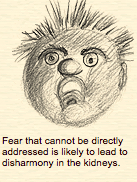Pain-Brain: How Odors Change Things Pt.2
- 16
- Mar
Pain-brain blues continue! In “The Smell of Pain,” an article published by the Naturopathic Doctor News and Review, Sarah A. LoBisco, ND, argues that chronic pain affects more people than diabetes, heart disease and cancer combined.
Based on researched compiled by the American Academy of Pain Management,
…50-75% of patients dying of cancer report pain, even though means were implemented to provide relief from their discomfort. Furthermore, after marijuana, prescription drugs for pain control are the second-most abused category of drugs in the United States, and the problem of overdose fatalities continues to rise.
Pain is a brain-mind control symptom, and points to other lifestyle issues:
The emotional turmoil, disruption of daily routines, and the desperation to relieve unrelenting pain could be contributing factors to [a] high
abuse rate of powerful analgesics. Currently, over half of pain sufferers feel hopeless about their condition and 77% report depression. Sixty percent of those in chronic pain experience breakthrough pain that interrupts their day, while 86% of chronic pain patients have sleep problems.
Read the entire technical and revealing article here.
Review of Generational Pain-Brain
In Part 1 of this article we cited her point about how fear based on certain smells was passed down to descendants of the mice subjects, even if they had never smelled the original scent.
This speaks volumes for the possible sensitizing of modern human diets marked by specific smells. Fried fish, chicken and waffles, ribs and peach cobbler come to mind.
Dick Gregory and Aris Latham famously advocate fresh and raw food to replace the fear-based diet of slavery. Legions insist that the wrong diet kills people. Never mind that centenarians may eat this diet….
It is true that poor diet, fear of the unknown, creaky bones and chronic pain all combined are debilitating people’s health. How can you function at optimum when any of these are present?
Pain-Brain and the Calming of Oils
In summarizing her overview, Dr. LoBisci noted,
The effects of aroma to quickly induce physical relaxation and decrease the activation of the sympathetic nervous system are important aspects of using essential oils for pain control.
In one oil-massage study, middle-aged women with hypertension were the subjects. Physiological shifts for older women often mean increased blood pressure (BP) and mind changes such as depression, anxiety, and insomnia.
A blend of lavender, marjoram, ylang-ylang, and neroli, in a ratio of 20:10:15:2, was used at 3% dilution in carrier oil.*
The women had five massage sessions within four weeks, with BP measurements at home and in the office.
The results were a significant and positive effect using an essential oil blend in subjects receiving aromatherapy versus controls, in terms of systolic blood pressure (SBP) and sleep quality.
Although the control group showed significant and gradual lowering of systolic BP, “there was no difference in diastolic blood pressure or 24-hour ambulatory BP across groups. Importantly, sleep quality was improved in the intervention group only.”
Without adequate sleep, all forms of pain persist, so this conclusion is noteworthy.
Physical Pain on the Man’s Brain
Whereas women’s pain is often connected to hormonal changes and monthly secretions or the stoppage thereof, men’s physical pain is connected to their sense of manhood. Joy DeGruy’s Respect Scale showed that when men don’t get respect, the eventual response can be violence.
The fight, flight, or freeze function in the amygdala (brain center) of men is socialized to the fight response. If a fight does not occur, however, the freeze function transfers the energy of fighting literally into the bones, where it freezes into pain.
This is our humble, energetic opinion, although scientific studies may be out there. Essential oils studies focused exclusively on men, for exploring this pain-brain emphasis, could not be found.
It goes without saying that men need the support of natural and strong substances to overcome their emotional impulses just as women do.
Oils for Men
“The Man’s Guide to Essential Oils” is a compilation by Men’s Fitness (dot com) and lists eucalyptus, chamomile, ginger, sandalwood, lavender, peppermint, lemon, and patchouli as generally good for men.
These oils have in common their ability to reduce inflammation –physical congestion leads to muscle/bone pain and skin problems. Patchouli is noted as strong-smelling, which I found funny since the aroma is often used in men’s colognes. (The piece was written by a woman.)
Back to the research– some Internet lists include pure essential oils typically recommended for women such as neroli,* jasmine and clary sage. They may appeal because men like the way the aromas, on women, make them feel. Feeling more calm, spiritually connected, and at peace with emotions are great antidotes to “pain-brain.”
In Conclusion
More dependable lists of pure oils for men’s holistic health include frankincense, myrrh, regular or garden sage, marjoram* and juniper. (Visit our posts about frankincense and sage on this site.)
Marjoram oil is consistently supportive of muscles and reduces body pain, while juniper, in both herb and oil form, is known for supporting kidney cleansing.
If your pain involves male reproductive organs, strengthening the cleansing ability of the kidneys and bladder is a must. It is also well known that a “kidney flush” must occur before a liver cleanse.
This follows the Traditional Chinese Medicine (TCM) axiom that the liver harbors anger. The kidneys harbor fear and fright. One must rid oneself of fear before anger can be dissolved.
As this is being addressed, the release of chronic pain, of generational or more recent origin, will probably not be far behind.
–Rev. Niamo Nancy Muid
*Lavender was used for its historic properties to balance the nervous system and its sleep promoting properties. Marjoram was selected for its reported parasympathetic nervous system modulation. For its hypotensive and heart rhythm modulation, ylang-ylang was included. Finally, neroli was added for its effect on sleep and mood. The main chemical constituents of these oils consisted of linalyl acetate (lavender), terpinen-4-ol (marjoram), benzyl acetate (ylang-ylang), and limonene (neroli).
The HealMobile is dedicated to dramatically improving your life. However, services and information on this website are not substitutes for medical or psychological diagnosis or prescription. We do not recommend treatment, caring for or cure of any disease. See a doctor or mental health professional for long-standing conditions. Share your interest in the self-care techniques mentioned here with him or her and note the response.






